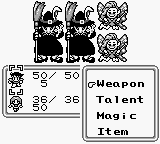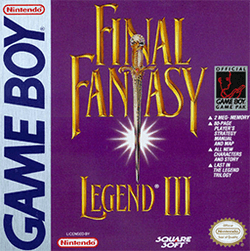Final Fantasy Legend III
| Final Fantasy Legend III | |
|---|---|
|
North American box art | |
| Developer(s) | Square |
| Publisher(s) |
Square |
| Director(s) | Kouzi Ide |
| Producer(s) | Chihiro Fujioka |
| Designer(s) |
Masanori Morita Hideshi Kyonen |
| Composer(s) |
Ryuji Sasai Chihiro Fujioka |
| Series |
Final Fantasy SaGa |
| Platform(s) | Game Boy, Nintendo DS |
| Release date(s) | |
| Genre(s) | Role-playing game |
| Mode(s) | Single-player |
Final Fantasy Legend III, originally released in Japan as Jikū no Hasha ~ Sa·Ga 3 [Kanketsu Hen] (時空の覇者 Sa・Ga3 [完結編] The Ruler of Time and Space ~ SaGa3 [Final Chapter]),[3][4] is a role-playing video game developed and published by Square Co. for the Game Boy handheld system as the third game of their SaGa series. Initially released for Japanese audiences in December 1991, the game was made available in North America nearly two years later in August 1993. While the title retains many similarities to its predecessors in terms of style and gameplay, the game's development was headed by series newcomer Chihiro Fujioka, who also served as composer alongside Ryuji Sasai. The North American version of the game saw a re-release alongside the two other Final Fantasy Legend titles in July 1998 courtesy of Sunsoft. In 2010, an enhanced remake of the game was announced for the Nintendo DS titled SaGa 3 Jikū no Hasha: Shadow or Light (サガ3時空の覇者 Shadow or Light SaGa3 The Ruler of Time and Space ~ Shadow or Light),[5] featuring three-dimensional graphics, new story elements, and an arranged soundtrack.
The story of Final Fantasy Legend III combines fantasy and sci-fi elements, with the player assuming the role of three characters who were sent back in time to prevent a massive global flood caused by a being known as the Pureland Water Entity from destroying the world. To accomplish their mission, the three heroes, along with companions aiding them on their journey, must travel through time by augmenting their flying time ship, the Talon, with 13 upgrade units from the past and future.
Gameplay

Interface for the game is a basic menu system. Players can view status and information from a character menu pressing Start. During combat, the player gives battle orders with menu's for each character in turn. The directional pad moves an image of a character representing the party while not in combat. Information is learned by talking to people and monsters. Final Fantasy Legend III instead of choosing character classes at the start of the game, a character's class may change by eating the meat of monsters and beasts, or installing the parts of cyborgs and robots after they are defeated in battle. Doing so will immediately effect a change in the character's class.
Each character starts at their default class (human or mutant depending on the character), and when fed meat will transform into a beast (if fed any kind of meat), and then a monster (if fed monster meat). When parts are installed into a character he/she will become a cyborg (by installing any kind of parts), and then a robot (by installing robot parts). Meat and parts counter each other: if a Beast has parts installed, he will revert to the default class; likewise, if a cyborg eats meat, he/she will also revert to the default class. Each class also has specific weak and strong points.
Plot
A creature known as the Pureland Water Entity engulfed the world in a great flood. The entity drew monsters onto the land and low lying cities have been abandoned. As a party of four warriors sets out to confront the entity, several youths from the future arrive to help, and it is realized that the Entity's destruction is occurring in the past and future as well.[6] The group then collects pieces of the ship Talon in the past, present, and future to defeat the Entity.[6]
Characters
- Arthur – The main character of the game. He was sent back in time from the future to the present. He starts out as a human fighter.
- Curtis – A mutant who was sent along with Arthur from the future. He is proficient in casting black magic.
- Gloria – A mutant who was sent along with Curtis and Arthur from the future. She is an able healer and a skilled user of white magic.
- Sharon – The granddaughter of the Elder of Dharm in the present. She is raised by her grandfather, along with the three youths sent from the future. She starts out as a human fighter who appears to have a minor crush on Arthur.
- Borgin- An influential leader in the future, Borgin masterminds the plan to combat Pureland by sending Arthur and the youths back in time, to the present.
- Myron- A powerful human warrior who grows up with and trains the party.
- Dion- A small boy of Dharm (possibly a relation to the Elder) who later grows up to be a rebel leader in the future.
- Faye- A small girl of Dharm (possibly Dion's sister) who later grows up as a powerful warrior and the only person who can take Xcalibur from Zhaakal.
- Lara- A young girl raised by Granny of Elan. She is brainwashed by Dogra, but Arthur eventually saves her.
Development
The game was the first project by Square's Osaka development department, who were later responsible for production of Final Fantasy Mystic Quest.[7] Producer Chihiro Fujioka noted that in addition to creating the game, they were also establishing themselves as a department, and as a result a great deal of effort was put into the game. The team decided to overcome the Game Boy's limitations by leaving some aspects to the player's imagination instead. In the case of graphics, this meant establishing first an object, then its shadows, allowing the player to visualize the missing colors themselves; a similar concept was applied to the game's music to overcome the limitation of working with only three notes for composition.[8]
As Fujioka worked on the game's programming, composer Ryuji Sasai stated he would handle the game's music; though a musician himself, Fujioka opted to contribute four additional songs to the game.[7] Sasai compared the limitations with the audio to a guitar capable of only six tones, though the cartridge capacity for the Game Boy at the time provided some difficulty. As a result, they concentrated on smaller songs, reducing the length of the tracks until they felt the music gave the proper impression.[9]
The English translation of Final Fantasy Legend III was the first project of translator Ted Woolsey at Square, given Final Fantasy II's translated script as an example and instructed to ensure "there were no ‘repeats’ of that mess".[10]
Nintendo DS version
In September 2010, Japanese magazine Famitsu announced that a remake of Final Fantasy Legend III for the Nintendo DS was being developed and would feature fully three-dimensional cel-shaded graphics.[5] It was released on January 6, 2011.
Reception
| Reception | ||||||||||||||||
|---|---|---|---|---|---|---|---|---|---|---|---|---|---|---|---|---|
| ||||||||||||||||
| ||||||||||||||||
Final Fantasy Legend III received mostly positive reviews, maintaining a 75% aggregate score on GameRankings.[11] Electronic Gaming Monthly called it "a good RPG" and "definitely a good buy", citing the game's graphics and story as its high points, giving it four reviewer scores of 8 out of 10 and an Editor's Choice Gold Award.[12] Nintendo Power largely agreed, stating that the game had "[e]xcellent game depth and good graphics for a Game Boy RPG", but found the title's story and gameplay to be too similar to previous Final Fantasy Legend games, warning "don't expect anything new in this game", giving the game a score of 3.35 / 5.[13] IGN called attention to the game's dated graphics and "imperfect" soundtrack, yet still found the game's music to be better than most Game Boy titles. They additionally found fault with the game's "poorly designed" equipment screen, stating it "makes distinguishing equipped items of the same class almost impossible", though declared it to be accessible even to novice players.[6] GamePro applauded the game for the battle simulator feature, the ability to transform the character using parts of slain enemies, and the booklets and map included in the game box. The made special note of the time travel mechanic, commenting that the experience of encountering characters in the past that the player has already met in the future is empowering and often humorous.[15]
GameDaily named it alongside the related Game Boy Final Fantasy titles as definitive games for the system, describing it as providing "hours of role-playing excitement, whether you were waiting in a dentist's office or on the way to Grandma's house."[16] The sentiment was shared by gaming magazines Electronic Gaming Monthly and Pocket Games, the latter of which ranked the titles together 8th out of the Top 50 games for the Game Boy.[14][17]
References
- ↑ "Game Boy (original) Games" (PDF). Nintendo. Archived from the original (PDF) on December 14, 2010. Retrieved April 14, 2011.
- ↑ An RPGamer Writer (January 24, 1998). "Sunsoft to Rerelease Square Game Boy Games". RPGamer. Retrieved April 14, 2011.
- ↑ "Sa·Ga All Sounds Soundtrack". VGM World. Retrieved June 23, 2008.
- ↑ "Saga 3" (in Japanese). Square Enix. Retrieved June 1, 2009.
- 1 2 "DS Remake News". Famitsu.
- 1 2 3 4 Sy, Dexter (June 14, 2000). "IGN: Final Fantasy Legend III Review". IGN. Retrieved April 10, 2008.
- 1 2 Kawazu Akitoshi, Uematsu Nobuo (2009-08-26). SaGa Series 20th Anniversary Original Soundtrack (DVD) (in Japanese). Square Enix. Event occurs at 7:36. SQEX-10145~65.
- ↑ Kawazu Akitoshi, Uematsu Nobuo (2009-08-26). SaGa Series 20th Anniversary Original Soundtrack (DVD) (in Japanese). Square Enix. Event occurs at 10:27. SQEX-10145~65.
- ↑ Kawazu Akitoshi, Uematsu Nobuo (2009-08-26). SaGa Series 20th Anniversary Original Soundtrack (DVD) (in Japanese). Square Enix. Event occurs at 9:57. SQEX-10145~65.
- ↑ Cifaldi, Frank (August 29, 2005). "Playing Catch-Up: Ted Woolsey". Gamasutra.com. Retrieved September 7, 2008.
- 1 2 "Final Fantasy Legend III for Game Boy". GameRankings. 2008. Retrieved April 10, 2008.
- 1 2 3 Martin Alessi, Danyon Carpenter, Ed Semrad and Sushi-X (August 1993). "Final Fantasy Legend III Review". Electronic Gaming Monthly (51): 44.
- 1 2 "Final Fantasy Legend III Review". Nintendo Power (52): 104. September 1993.
- 1 2 Staff (Summer–Fall 1999). "Top 50 Games". Pocket Games (1): 32.
- ↑ "Final Fantasy Legend III". GamePro (51). IDG. October 1993. p. 31.
- ↑ "Retro Rewind: Game Boy". GameDaily. AOL. Archived from the original on October 24, 2008. Retrieved June 1, 2009.
- ↑ Staff (1999). "Game Boy Pocket". Electronic Gaming Monthly Buyer's Guide (7): 55.
External links
- Official Square Enix info page (Japanese)
- Official Nintendo DS remake website (Japanese)
